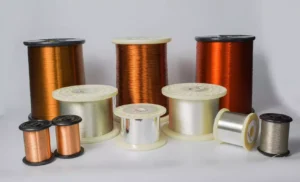BLDC fans use modern, efficient brushless DC motors, while normal fans rely on older AC motor technology.
This core difference makes BLDC fans consume less power, last longer, operate more quietly, and offer better speed control.
Now, let’s look closer at these differences.
This will help you decide which fan type is the best fit for your home and needs.
Main Differences Between Normal Fans vs BLDC Fans
Fans might look similar on the outside.
But hidden differences greatly affect your electricity bill and daily comfort.
The biggest difference lies in the motor. BLDC fans feature advanced Brushless Direct Current motors controlled electronically.
Normal fans use traditional Alternating Current (AC) induction motors with mechanical brushes.
This fundamental difference impacts energy use, lifespan, noise, and overall performance.
Let’s dive deeper into what sets these fans apart.
The technology inside the fan is the main reason for the differences in how they work and how much energy they use.
Normal fans, the kind most homes have used for years, run on an AC induction motor.
These motors use brushes and a part called a commutator to make the fan spin.
This system works, but it has downsides. The brushes wear down over time, creating friction and heat.
This friction wastes energy and makes the fan noisier.
It also means the fan won’t last as long before needing repairs or replacement.
BLDC fans, however, use a completely different approach.
They have a Brushless Direct Current motor.
As the name suggests, there are no brushes.
Instead, electronics control the flow of electricity to the motor parts (stator and rotor).
This electronic commutation is much more efficient. There’s almost no energy lost to friction.
This is why BLDC fans use so much less electricity – often only 28 to 35 watts compared to 75 to 90 watts for a standard AC fan.
This difference adds up to significant savings on your energy bills over the fan’s lifetime.
The lack of brushes also means less wear and tear, leading to a longer lifespan for the fan.
They also run much quieter because there’s no friction noise from brushes.
Furthermore, the electronic control allows for very precise and smooth speed adjustments, unlike the often limited speed settings on older fans.
While the initial purchase price of a BLDC fan might be higher, the long-term savings on electricity and potential replacement costs often make them a more economical choice in the long run.
Motor Technology Explained
Traditional fans use AC induction motors.
These motors rely on electromagnetic induction and mechanical brushes to rotate.
This design is older and less efficient.
BLDC fans use electronically commutated motors.
Smart electronics manage the power delivery without physical contact, reducing friction and energy waste significantly.
Energy Savings Comparison
This is a major advantage for BLDC fans.
A typical AC fan might consume 75-90 watts.
A comparable BLDC fan often uses only 28-35 watts.
This translates to energy savings of 50-65%, directly impacting your electricity bills month after month.
Performance and Control
While older fans might offer basic speed settings, BLDC fans provide much smoother and more precise speed control.
Their electronic controls allow for finer adjustments.
They also maintain a consistent speed even if your home’s voltage fluctuates slightly, ensuring steady airflow and comfort.
Lifespan and Durability
Friction is the enemy of longevity in motors.
The brushes in AC motors wear down over time, eventually leading to failure.
BLDC motors, lacking these brushes, experience far less mechanical wear.
This results in a significantly longer operational lifespan, meaning you won’t need to replace the fan as often.
Cost Considerations
It’s true that BLDC fans usually have a higher upfront purchase price than traditional AC fans.
However, this initial investment is often recouped over time through lower electricity bills.
Consider the total cost of ownership, including purchase price and running costs, when making your decision.
What is a BLDC Fan?
A BLDC fan is simply a fan that uses a Brushless Direct Current (BLDC) motor instead of a traditional AC motor.
It uses smart electronics, not physical brushes, to control power, making it much more energy-efficient, quieter, and longer-lasting.
Let’s break down what “Brushless Direct Current” really means for a fan.
The key is the absence of “brushes.”
In older AC motors, small carbon blocks called brushes physically touch a rotating part (the commutator) to pass electricity and make the motor spin.
This physical contact creates friction, which wastes energy as heat and causes the brushes to wear out over time.
BLDC motors eliminate these brushes entirely.
Instead, they use sophisticated electronic circuits and sensors to manage the flow of electrical power between the stationary part (stator) and the rotating part (rotor).
This process is called electronic commutation.
How Electronic Commutation Works
Think of it like a smart traffic controller for electricity.
Sensors detect the rotor’s position, and the electronic controller precisely directs the electrical current to the right coils in the stator at the exact right time.
This creates magnetic fields that push and pull the rotor, making it spin smoothly and efficiently without any physical contact needed for power transfer.
This lack of friction is a game-changer.
Significant Energy Reduction
Because there’s no energy lost to friction, BLDC motors are incredibly efficient.
As mentioned, while a standard fan might use 75-90 watts of power, a BLDC fan achieves the same or better airflow using only about 28-35 watts.
This is a massive reduction, often cutting energy consumption by more than half (50-65% less power).
Over a year, this difference can lead to noticeable savings on your electricity bill, especially if you use fans frequently or have multiple fans in your home.
Less Heat, Longer Life
Another benefit of reduced friction is less heat generation.
Traditional AC motors can get quite warm during operation.
BLDC motors run much cooler.
This lower operating temperature is not only more efficient but also puts less stress on the motor components, contributing significantly to the fan’s longer lifespan.
Less wear and tear means fewer potential points of failure.
These fans are designed to provide consistent airflow for many years, making them a durable investment for both homes and commercial spaces where reliability is important.
Advantages of BLDC Fans
BLDC fans bring significant benefits to your home.
They offer huge energy savings, often using up to 65% less electricity.
They also last longer due to less wear, run much quieter, provide precise speed control, and frequently include handy remote or smart features.
Let’s look closer at why BLDC fans are becoming so popular.
The advantages go beyond just saving energy; they improve comfort and convenience too.
Understanding these benefits helps you see the value behind the technology.
Huge Energy Efficiency
This is perhaps the most talked-about benefit.
As we’ve seen, BLDC fans consume significantly less power – typically 28-35 watts compared to 75-90 watts for older AC fans.
This isn’t a small difference.
Over the course of a year, especially in warmer climates or homes where fans run often, this can lead to substantial savings on electricity bills.
Imagine cutting the running cost of your fans by more than half.
This efficiency also means a smaller environmental footprint, which is increasingly important.
Longer Operational Lifespan
The design of BLDC motors directly contributes to their durability.
The absence of brushes eliminates the main source of wear and tear found in traditional fan motors.
Less friction means less heat and less physical degradation of components.
This translates to a fan that is likely to last much longer than its AC counterpart, potentially 10-15 years or more with proper care, reducing the hassle and expense of replacements.
Superior Speed Control
BLDC fans offer a level of speed control that older fans usually can’t match.
Instead of just three or four fixed speed settings, the electronic controls allow for smooth, gradual adjustments.
This means you can fine-tune the airflow precisely to your comfort level.
Many models come with multiple speed settings accessible via remote control, offering greater flexibility.
Whisper-Quiet Operation
The mechanical friction from brushes in AC motors is a primary source of operational noise.
By eliminating brushes, BLDC fans run significantly quieter.
This makes them an excellent choice for bedrooms, nurseries, offices, or any space where noise levels are a concern.
You get the cooling airflow without the distracting hum.
Convenient Remote and Smart Features
Many BLDC fans incorporate modern conveniences.
Remote controls are common, allowing you to adjust speed, set timers, or even change the fan’s direction without getting up.
Increasingly, BLDC fans also come with smart features.
This might include integration with smart home systems (like Alexa or Google Assistant) or control via smartphone apps, offering advanced scheduling and automation options.
Stable Performance During Voltage Fluctuations
Minor dips or surges in your home’s electrical voltage can sometimes affect the speed and performance of traditional AC fans.
BLDC fans, with their sophisticated electronic controls, are generally better at maintaining a consistent speed and performance even when voltage isn’t perfectly stable.
This ensures reliable comfort without annoying speed variations.
BLDC Fans vs Normal Fans: Other Technical Differences
Need a quick way to compare the technical details side-by-side?
Feeling confused by all the specifications?
Here’s a clear breakdown of the other important technical differences.
Beyond the basics, key technical distinctions include the motor type (advanced Brushless DC vs. older AC Induction), power draw (much lower for BLDC), noise levels (quieter BLDC), heat output (minimal from BLDC), expected lifespan (longer for BLDC), and control precision (better with BLDC).
Understanding the technical specifications helps clarify why BLDC fans perform differently.
Let’s look at these differences more closely, including a direct comparison.
Feature Comparison Table
Here is a table summarizing the main technical differences:
| Feature | BLDC Fan | Normal Fan (AC Induction) | Notes |
|---|---|---|---|
| Motor Type | Brushless DC Motor | AC Induction Motor | Core difference affecting all other aspects |
| Power Consumption | 28-35 watts (Typical) | 75-90 watts (Typical) | Significant energy savings with BLDC |
| Noise Level | Low | Higher (due to friction) | BLDC is quieter |
| Heat Generation | Minimal | Considerable | BLDC runs cooler, aids longevity |
| Lifespan | Longer | Shorter (due to wear) | Fewer moving parts in BLDC motor |
| Speed Control | Precise electronic control | Limited mechanical control | BLDC offers smoother adjustments |
| Remote Control | Often Available | Usually Not Available | Added convenience with many BLDC models |
| Voltage Fluctuation | Performance Unaffected | Performance Affected | BLDC maintains speed better |
Impact of Motor Type
The Brushless DC motor is inherently more efficient due to its electronic commutation, eliminating energy losses from friction common in AC induction motors with brushes.
Power Consumption Implications
The stark difference in wattage (28-35W vs 75-90W) directly translates to lower running costs for BLDC fans.
This is a primary driver for choosing BLDC technology, especially for long-term use.
Noise and Heat Differences
Less friction in BLDC motors means less noise and significantly less heat generated during operation.
A cooler running motor contributes to a longer lifespan and doesn’t add unwanted heat to the room.
Lifespan Factors
The primary wear component in AC fan motors is the brushes.
Eliminating these in BLDC motors removes a major failure point, leading to increased durability and a longer expected operational life.
Control and Convenience
Electronic control in BLDC fans allows for very precise speed settings and often enables features like remote controls or smart home integration, which are typically absent in basic AC fans.
The ability to maintain speed during voltage dips also ensures consistent comfort.
What You Must Look Into Before You Pick Any Fan
Before choosing any fan, think about your room size and required airflow (air delivery).
Also consider your energy saving goals, desired speed control options (like remotes), budget (upfront cost vs. long-term savings), noise tolerance, and how much maintenance you prefer.
Selecting the right fan involves more than just picking a style you like.
Matching the fan’s capabilities to your specific needs ensures you get the comfort and performance you expect.
Let’s explore the key factors you should evaluate.
Energy Usage Goals
How important are energy savings to you?
If reducing your electricity bill is a high priority, a BLDC fan is the clear choice due to its significantly lower power consumption (28-35W vs 75-90W for AC fans).
While they cost more initially, the long-term savings can be substantial.
If upfront cost is the main concern and energy use is secondary, a traditional AC fan might suffice, but be aware of the higher running costs.
Room Size and Air Delivery
Fans are designed to move a certain amount of air, often measured in CFM (Cubic Feet per Minute), although size (like 1200mm or 1400mm blade span) is a common indicator.
A large room needs a fan that can circulate more air effectively than a small room.
Check the fan’s specifications for recommended room sizes or air delivery ratings.
Choosing a fan that’s too small won’t cool the space adequately, while one that’s too powerful might create uncomfortable drafts in a small area.
Match the fan’s capacity to your room’s dimensions.
Speed, Control, and Features
How much control do you want over the fan’s speed?
Basic AC fans might only offer 3 speeds via a pull chain.
BLDC fans typically offer more speed settings and smoother transitions, often controlled by a remote.
Consider if you want features like timers, reversible direction (for winter use), or smart home integration.
BLDC fans are more likely to offer these advanced options.
Durability and Maintenance Needs
Do you prefer a low-maintenance appliance?
BLDC fans, lacking brushes that wear out, generally require less maintenance and are expected to last longer than traditional AC fans.
If longevity and minimal hassle are important, the durability of a BLDC fan is a significant advantage.
Smart Home Integration
Are you building a smart home?
If you want to control your fan using voice commands (Alexa, Google Assistant) or smartphone apps, look specifically for BLDC fans with smart capabilities.
While not all BLDC fans are smart, the technology lends itself well to these integrations, which are rarely found on standard AC fans.
Budget: Upfront vs. Long-Term
Consider your budget carefully.
Traditional AC fans have a lower purchase price.
BLDC fans cost more upfront.
However, you must factor in the long-term running costs.
Calculate the potential electricity savings from a BLDC fan over its expected lifespan to determine the total cost of ownership.
The higher initial investment in BLDC might pay off significantly over several years.
Noise Levels
How sensitive are you to noise?
For bedrooms, offices, or quiet living spaces, the lower noise output of a BLDC fan is a major plus.
The lack of brush friction makes them operate much more quietly than most AC fans.
If fan noise is a potential annoyance, prioritize a BLDC model.
Conclusion
BLDC fans clearly offer better efficiency, longer life, and more features.
While they cost more initially, their long-term energy savings and improved comfort make them a smart investment for many homes.
FAQs
How does the energy efficiency of BLDC fans compare to traditional fans?
BLDC fans are much more efficient, using about 28-35 watts compared to 75-90 watts for traditional fans. This significant difference means BLDC fans can save up to 65% on electricity.
Which fan is best: normal fan vs BLDC fan?
For lower energy bills, quieter operation, a longer lifespan, and precise control, BLDC fans are generally the better choice. Normal fans cost less initially but more to operate.
Are BLDC fans really worth it?
Yes, often they are. While the upfront cost is higher, the long-term savings from lower electricity use, combined with durability and better features, make them a valuable investment for many.
Do BLDC fans save electricity?
Definitely. They consume significantly less power than standard AC fans, typically using 50-65% less energy. This leads directly to noticeable savings on your electricity bills over time.
What is the disadvantage of a BLDC fan?
The primary drawback is their higher initial purchase price compared to traditional fans. Some users also note that repairs might be more complex due to their electronic components.
How long do BLDC fans last?
BLDC fans typically have a longer lifespan than normal fans, often lasting 10 to 15 years or more. Their brushless design results in less wear and tear on motor parts.
Are BLDC fans quieter than normal fans?
Yes, BLDC fans are significantly quieter. The absence of mechanical brushes reduces friction, which is a primary source of noise in conventional AC fan motors.
Do BLDC fans need maintenance?
Generally, BLDC fans require less maintenance. Because they lack brushes that wear down and need replacement, there are fewer components likely to need regular service compared to traditional fans.






